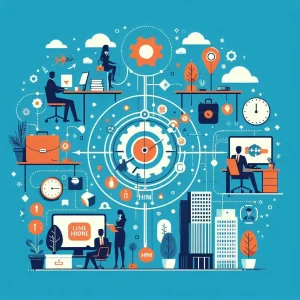In today’s fast-paced business environment, efficiency and productivity are paramount. Human Resource Management Systems (HRMS) have revolutionized the way offices operate, streamlining numerous processes and making everyday tasks easier for employees across various departments. Here’s a look at how HRMS can simplify some critical jobs in an office setting:
1. Recruitment and Onboarding
Recruitment: Traditionally, the recruitment process involves sorting through resumes, scheduling interviews, and coordinating with various stakeholders. An HRMS automates many of these tasks, from posting job listings on multiple platforms to screening candidates using AI-driven algorithms. This ensures that only the most qualified candidates are considered, saving HR professionals countless hours.
Onboarding: Once a candidate is hired, the onboarding process can be equally time-consuming. HRMS solutions provide automated checklists, document management systems, and e-signature capabilities. This means new hires can complete necessary paperwork, receive training materials, and get acclimated to the company culture more efficiently, reducing the administrative burden on HR staff.
2. Payroll and Benefits Administration
Managing payroll and benefits manually is fraught with the potential for errors and delays. An HRMS simplifies this by:
- Automating payroll calculations to ensure accuracy and compliance with tax regulations.
- Tracking employee benefits, including health insurance, retirement plans, and paid time off.
- Facilitating direct deposits and generating pay slips automatically.
These features not only save time but also enhance employee satisfaction by ensuring they are paid correctly and on time.
3. Performance Management
Performance reviews are critical for employee development but can be labor-intensive to manage. An HRMS streamlines this process by:
- Providing templates for performance reviews.
- Automating the scheduling of review meetings.
- Allowing managers and employees to set and track goals.
- Offering analytics to help managers make data-driven decisions about promotions and raises.
By automating these tasks, HRMS enables managers to focus more on meaningful conversations with their employees, fostering a more productive and engaged workforce.
4. Compliance and Reporting
Maintaining compliance with labor laws and regulations is a complex task. An HRMS helps in:
- Keeping track of regulatory changes.
- Ensuring that employee records are up-to-date and stored securely.
- Generating compliance reports automatically.
This reduces the risk of non-compliance and the potential for costly penalties, providing peace of mind for HR departments.
5. Employee Self-Service
An often-overlooked aspect of HRMS is its ability to empower employees through self-service portals. These portals allow employees to:
- Update their personal information.
- Apply for leave.
- Access pay slips and tax documents.
- Enroll in benefits programs.
By enabling employees to manage their own information, HR staff are freed up to focus on more strategic initiatives, rather than routine administrative tasks.
6. Training and Development
Continuous learning and development are crucial for employee growth and company success. An HRMS supports this by:
- Offering a centralized platform for training modules and courses.
- Tracking employee progress and certifications.
- Providing analytics to identify skill gaps and training needs.
This ensures that employees have access to the resources they need to develop professionally, while managers can easily monitor and support their growth.
The implementation of an HRMS can significantly simplify and enhance various office jobs, from recruitment and onboarding to payroll, performance management, compliance, and employee self-service. By automating routine tasks and providing valuable insights through analytics, HRMS solutions enable HR professionals and managers to focus on strategic initiatives that drive business success. In an era where efficiency is key, adopting an HRMS is not just a technological upgrade, but a strategic move towards a more productive and engaged workplace.





